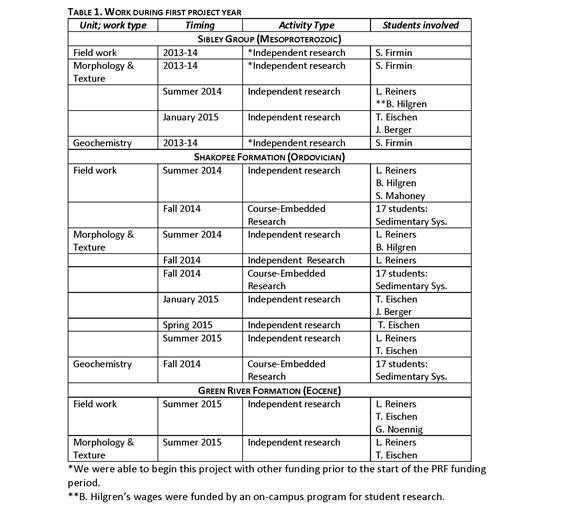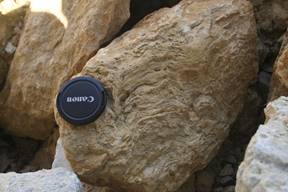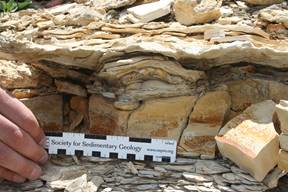Reports: UR854410-UR8: Stromatolites in Atypical Environments: From Mesoproterozoic to Modern
Julie K. Bartley, PhD, Gustavus Adolphus College
This project examines four stromatolite-bearing successions, comparing them with one another and with other studied units, at several scales. The work plan includes field research, hand-sample and thin-section scale textural and morphologic analysis, and geochemical analysis of four stromatolite successions. The four successions to be examined are the Sibley Group; Shakopee Formation; Green River Formation; and Belt Supergroup. All aspects of the project involve student-faculty research collaborations. The first grant year, the subject of this report, includes the work of two summers (2014, 2015) and the intervening academic year (2014-15). Table 1 outlines the types of work done and the student researchers involved in the work. The research narrative that follows summarizes some of the preliminary findings and impacts.
Table 1 summarizes the research activities, types of research, and students involved. In all, 20 individual students participated in this project during the first year.
Sibley Group, Ontario
Prior to receiving the PRF grant, PI Bartley was invited to work on Channel Island and surrounding islands in southern Ontario. She conducted fieldwork and follow-up laboratory analysis with student Sydney Firmin, who was able to begin the project early, conducting textural and geochemical analysis on the Sibley stromatolites. During the funding period, work by students Lindsey Reiners, Bailey Hilgren, and John Berger extended the project further.
Main findings
The texture and geochemistry of the Sibley Group stromatolites suggests deposition in a very shallow, hypersaline lake during the Mesoproterozoic.
Impact on investigators
- Sydney Firmin presented initial results at the 2014 Institute on Lake Superior Geology in Hibbing, MN
- John Berger presented results at the 2015 North-Central GSA meeting in Madison, WI
- Julie Bartley presented results of this work at the 2015 International Limnological Congress in Reno, NV
Research in the Shakopee Formation began in the summer of 2014 with a field research trip. PI Bartley and three students visited four localities in southeastern Minnesota. Several stromatolite horizons were identified, measured, and sampled. Lindsey Reiners and Bailey Hilgren continued work during the summer, cutting slabs for thin section and cathodoluminescence, and comparing morphology and texture of Shakopee stromatolites to those of the Sibley Group.
Work continued during the fall of 2014 when the 17 students in the Sedimentary Systems class returned to these localities to continue research on smaller, independent class projects. These projects included looking at porosity differences throughout the formation, stromatolite growth patterns, conodont biostratigraphy, and trace element chemistry.
Student Tanner Eischen explored the texture of the Shakopee stromatolites during January and Spring 2016, examining thin sections, hand samples, and slabs by cathodoluminescence.
Main findings
The diverse course-embedded projects suggest that further textural work would be fruitful and that primary porosity could be evaluated quantitatively in these stromatolites; that conodonts are exceedingly rare in the stromatolitic facies and are unlikely to be useful biostratigraphic indicators; that diagenesis is complex in the Shakopee Formation; and that geochemistry does not suggest strong hypersalinity as indicated for the Sibley Group. The January and Spring follow-up research suggests that stromatolites of the Shakopee Formation are texturally more like their Precambrian counterparts than like modern, Shark-Bay style stromatolites.
Impact on investigators
- Lindsey Reiners and Bailey Hilgren presented data at Gustavus’s fall research symposium.
- Sedimentary Systems students created posters for in-class presentation of results.
- Tanner Eischen presented results (with Reiners and Hilgren as coauthors) at the North-Central section meeting of GSA in Madison.
Main findings
Since the investigation of the Green River stromatolites is in its early stages, we don’t yet have significant conclusions. Preliminary work, though, suggests that a diverse array of fabrics are present, and that primary porosity varies substantially across fabrics.
Impact on investigators
- Three students acquired significant experience working in well-exposed, but remote outcrop.
- The PI established professional contacts in the large scientific community working on the Green River Formation
This project has involved a total of 20 individual students, working on three of the four units to be targeted in this project. The fourth unit, the Belt Supergroup, could not be visited this summer, due to the intense wildfire season in Montana. Current plans are to conduct that fieldwork next summer. PRF funds have supported three students with stipends; Gustavus funds have provided additional support to expand the research team. In addition, the PRF has supported the participation of the remaining students in the project. All students involved in the project have presented preliminary results at least once. Work on the Sibley Group is sufficiently complete to begin manuscript preparation during the upcoming academic year, and PI Bartley will be giving a talk that includes some of these data when she accepts an award in November from the Midstates Consortium for Math and Science.
From a scientific perspective, it is clear that stromatolite textures, and the resultant primary and secondary porosities, vary substantially as a function of depositional environment and age, and that our multi-proxy approach to investigating stromatolite genesis is an effective one.

















